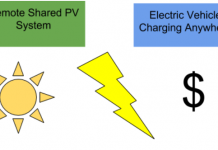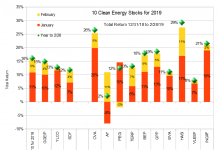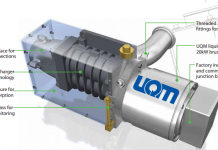Tom Konrad, Ph.D., CFA
- Seaspan Worldwide has several classes of publicly traded securities, with different claims on its income streams.
- The company owns container ships leased under long term contracts to shipping companies.
- The shipping industry is in a massive downturn, raising concerns about its customers’ ability to pay.
- The company’s preferred shares have sold off more than half as far as its common stock- far more than justified by its relatively low risk.
- There exists a 5.5% yield opportunity to buy the preferred and hedge the risk by buying puts on the common.
Seaspan Corporation operates as an independent charter owner and manager of containerships. The company charters its containerships under to long-term, fixed-rate time charters to various container liner companies. Its fleet consists of 92 vessels, which are typically newer, larger, and more fuel efficient than other fleets.
Seaspan’s top customers included COSCO Container Lines, Mitsui O.S.K. Lines, MOL, Yang Mine and Hapag-Lloyd. It also had three ships chartered to bankrupt Hanjin shipping. Although one of these ships has already been rechartered, the bankruptcy highlighted the fact that Seaspan’s income and (more importantly) dividend are not safe.
Available Cash Flow
A recent article on Seaspan by transportation professional James Sands looks at the prospects of a dividend cut going forward. He seems to think that a dividend cut is possible, and may even be likely because the company may decide to expand its fleet by purchasing vessels for sale at distressed prices.
Seaspan’s dividends currently amount to $13 million a quarter to preferred shareholders, and $38.3 million to common shareholders. Cash available for distribution to common shareholders (CAFD) was $90 million in the third quarter (after the $13 million payment to preferred shareholders.) Third quarter revenue was $225 million.
Understanding Cumulative Preferred Stock
The company’s preferred shares (SSW-PD, SSW-PE, SSW-PH, and SSW-PG) are what is known as “cumulative” preferred. Preferred equity falls in between common stock and debt (bonds) on the spectrum of risk and reward: safer with less potential for upside than common stock, but higher yield and riskier than bonds. Preferred shares must receive their full dividend so long as any dividend is paid to the common shareholders. Cumulative preferred shares have the additional provision that, if dividends are ever suspended, all unpaid preferred dividends must be paid in arrears before any dividend is paid to common shareholders.
This means that preferred dividends are much less risky than common dividends. Expenses are mostly fixed, so declines in revenue will flow mostly flow through directly to CAFD, so let us assume that each $10 decrease in revenue reduces CAFD by $9.
Dividend Cut Estimates
Under these assumptions, let us consider the effects of the following percentage declines in quarterly revenue:
| Seaspan Quarterly Revenue, CAFD, and dividends. All numbers in million $. | ||||
| % Decline in Revenue | Quarterly Revenue | CAFD | Common dividend | Preferred divideds |
| no decline | $225 | $90 | $38.3 (2.3x coverage) | $13 (safe) |
| 10% decline | $202 | $70 | $38.3 (1.8x coverage) – cut possible | $13 (safe) |
| 20% decline | $180 | $50 | $38.3 (1.3x coverage) – likely to be cut | $13 (safe) |
| 30% decline | $157 | $29 | Dividend cut inevitable, possibly to 0 | 3.25x coverage, may be delayed |
| 40% decline | $135 | $9 | Dividend will be cut to 0 | 1.7x coverage, likely to be delayed |
| 50% decline | $112 | -$11 | cannot be paid | cut to $0, will only be paid if revenues recover. |
In summary, Seaspan will continue to have enough cash flow to continue paying the preferred dividends unless revenue falls by more than 50%. Since the vast majority of Seaspan’s revenue comes from long term leases with major shipping companies, this would require that at least a third of its customers (as a percentage of revenues) go bankrupt- the only way to avoid paying a long term lease. Revenue may also decline over time as leases end, offset as Seaspan re-leases the vessels, possibly at lower rates.
Now comes the tricky part- predicting the future. If a large number of shipping companies go bankrupt and scrap or idle older, less efficient vessels, revenues and lease rates should improve for the remaining vessels. Since Seaspan’s vessels are generally newer and cheaper to operate than most of the world fleet, Seaspan should be a net beneficiary of this trend. Hence, a 50% decline in revenue seems nearly impossible. Keeping this in mind, here are my guesstimates of the likelihood of the above scenarios:
| % Decline in Revenue | Likelihood | Expected common dividend cut | Expected preferred dividend cut |
| no decline | 10% | 20% | no cut |
| 10% decline | 30% | 30% | no cut |
| 20% decline | 30% | 50% | no cut |
| 30% decline | 20% | 80% | 10% |
| 40% decline | 5% | 100% | 50% |
| 50% decline | 5% | 100% | 80% |
Using these probabilities, I can estimate the expected dividend cuts for both the common and preferred. Using these probabilities, the overall expected dividend cut for the common is 52%, and the expected dividend cut for the preferred is 8.5%.
If my guesstimates are correct, another way to say this is that the common dividend is likely to be cut six times as much as the preferred dividends. This makes sense, since the common dividend has to be cut to $0 before there can be any cut to the preferred dividends.
Effects on the Stock Price
Understanding the effects of dividend cuts on the stock price requires knowing why shareholders own the stock. Preferred shareholders are income investors, and so a
re motivated almost exclusively by dividends. Common shareholders are motivated by a mix of income and potential capital gains. SSW investors are likely more motivated by income than average, given that the stock’s dividend yield is currently over 15%. Let’s say that common shareholders are motivated one third by capital gains and two-thirds by income.
If that is the case, my estimated dividend cuts should have led to an approximate 35% decline in the common shares, and an 8.5% decline in the preferred. Reality has been different, as shown by the chart below:
Over the last 6 months, SSW (black line) has fallen 36% (close to my estimate), while the preferred share classes (red and orange lines) have fallen about 19%, more than half as much as the common. Also shown are Seaspan’s exchange traded notes SSWN (blue line), which have declined only 2%, a fall which could be completely explained by recent increases in interest rates. The performance of SSWN shows that the market thinks that Seaspan is little more likely to go bankrupt than it was six months ago.
Arbitrage
While the decline in SSW is eerily close to my very rough estimate (36% vs 35%), the decline in the preferred shares is completely out of proportion. The preferred shares have fallen more than twice as far as my model would predict.
I believe this is due to excessive risk aversion among the preferred shareholders. Valuing income above all else, I believe that the preferred shareholders are over-reacting to the actual risks. The only other options are that my model is wrong, or that common shareholders are not taking the risks seriously enough.
While my model is very rough, the fact that risks for common shareholders are much higher than those for preferred shareholders is an inevitable consequence of the way preferred shares are designed. Perhaps the expected common dividend cut should not be six times the expected preferred cut, but it could as easily be ten times as large or three times as large. The resulting declines in the common stock should hence be a significant multiple of the declines in the preferred. I find the actual ratio of only 1.9x far too small.
Investors could in theory take advantage of this mispricing by buying the preferred stock and shorting the common. If the common “should” decline 3x as much as the preferred, they can short $1 of the common for every $3 of the preferred they buy. Taking SSW-PG, the company’s cumulative 8.2% preferred as an example (currently yielding 10% at $20.50) an investor could short 1000 shares of SSW for $9,500, with an annual cost of $1500 in dividends, and buy 1390 shares of SSW-PG for $28,500 which pay annual dividends of $2,850. Hence, a net investment of $19,000 would yield a net $1,350 in dividends (6.8%) and be largely hedged against risks to the company.
Unfortunately, Seaspan shares are difficult to borrow, and so a more achievable hedge is to use long-dated puts. May 2017 SSW $7.50 puts can currently be bought at approximately $0.60 per share. While these do not insulate the investor against small declines in SSW, they are an excellent hedge against the large declines in the stock, which would occur if the common dividend were cut to $0 and the preferred dividends were at risk. For a hedge similar to the 1000 shares of SSW sold short above, an investor would need 10 contracts which would cost $600 plus commission and hedge the position for six months. During that time, the 1390 shares of SSW-PG would pay $1425 in dividends, so the net annual yield would be 5.5% on the whole hedged position, assuming that new puts could be sold for similar prices every 6 months.
5.5% is an attractive yield for a stock market investment, made even more attractive by the relatively low risk nature of this hedged investment in preferred stock. It also has the potential of significant capital gains if the preferred shares recover to something closer to their true value.
This is why I have been buying SSW-PG and hedging part of that position with puts on SSW.
Endnote: Is Seaspan Green?
Regular readers may wonder why I’m interested in Seaspan at all, given that I do almost exclusively green investing. Global container shipping is a key part of world trade, the antithesis of the “buy local” movement. Buying local is often seen as green, but in my opinion, that depends on what you are buying and how it was made.
I admit that this is very subjective, so if you think that global trade is always bad, you should avoid investing in Seaspan. That said, here is why I consider Seaspan green:
- Shipping is, pound for pound, the most fuel efficient way to move goods over long distances.
- Seaspan’s ships are among the world’s most efficient.
- Fuel efficiency can be further improved by “slow steaming,” a.k.a. going more slowly. Slow steaming requires more ships to move a fixed number of goods the same distance in the same amount of time, and so this easy way to reduce fuel use has the effect of increasing the demand for ships, which in turn benefits Seaspan.
In short, I expect that Seaspan should be a net beneficiary of worldwide efforts to reduce greenhouse gas emissions and fuel use. This precisely my definition for a “green” stock. I invest in companies I believe will gain from efforts to fight climate change and other environmental problems.
DISCLOSURE: Long SSW-PG. Long Puts on SSW common.
DISCLAIMER: Past performance is not a guarantee or a reliable indicator of future results. This article contains the current opinions of the author and such opinions are subject to change without notice. This article has been distributed for informational purposes only. Forecasts, estimates, and certain information contained herein should not be considered as investment advice or a recommendation of any particular security, strategy or investment product. Information contained herein has been obtained from sources believed to be reliable, but not guaranteed.









